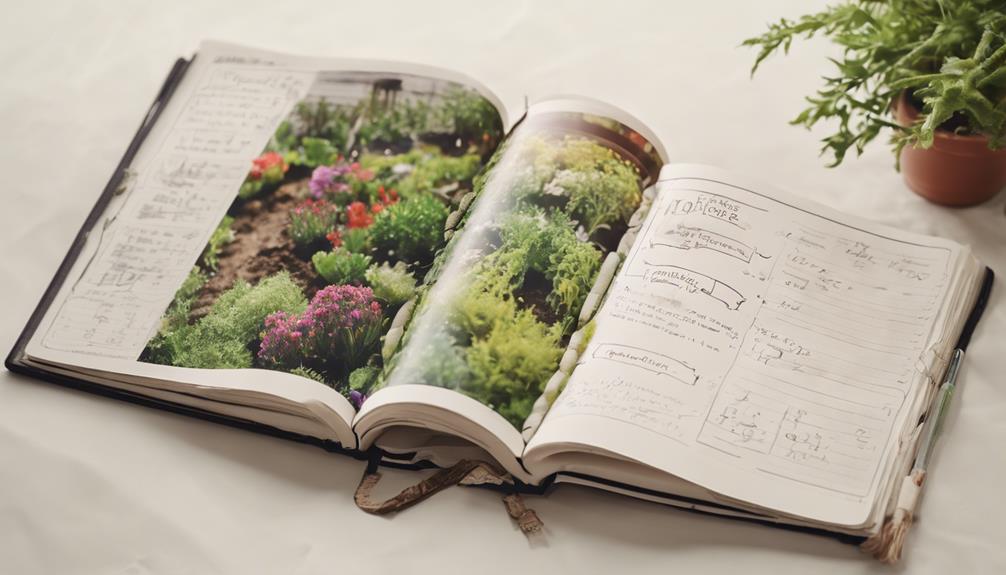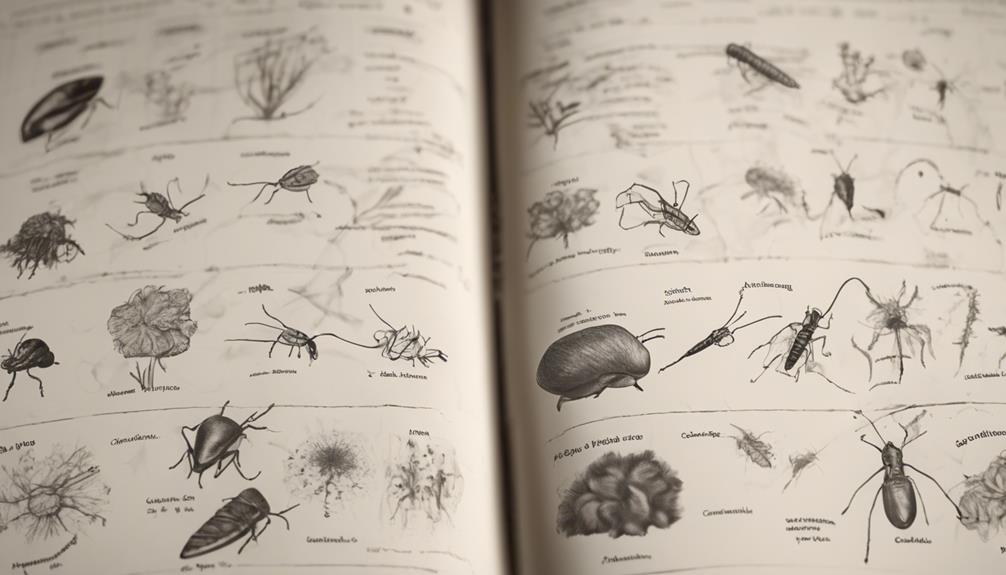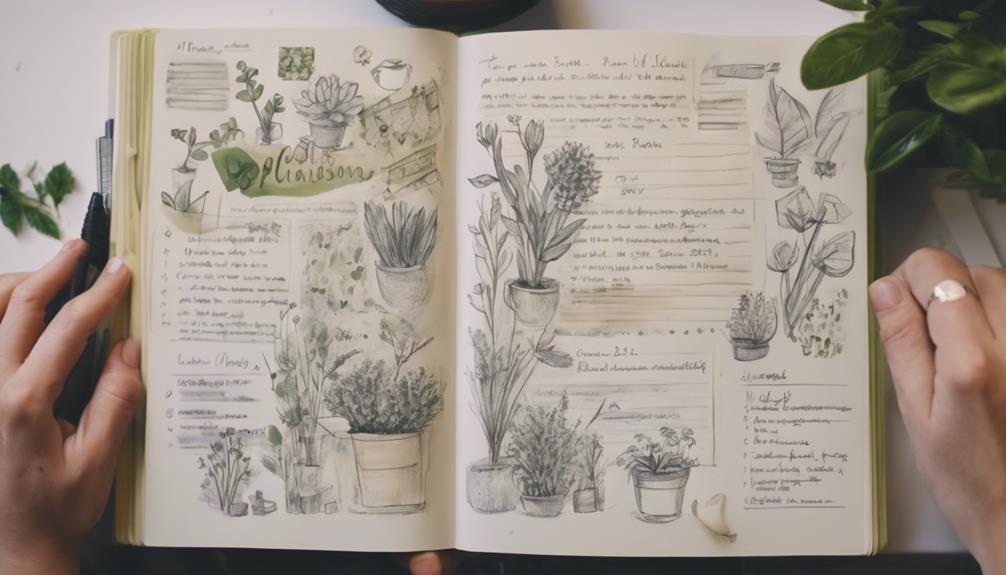As you tend to your garden, each seed planted is like a small promise of growth and beauty. But have you considered the power of capturing these moments in your gardening journal?
The simple act of jotting down your horticultural journey can unveil a wealth of insights and improvements to your gardening practices. From documenting plant progress to reflecting on harvests, your journal becomes a treasure trove of knowledge waiting to be unearthed.
Key Takeaways
- Enhance horticultural experience through journaling.
- Document plant progress and environmental factors for optimal growth.
- Utilize imagination in garden design for visual appeal.
- Track pests, diseases, harvests, and reflect for continuous improvement.
Benefits of Gardening Journals

Keeping a gardening journal can significantly enhance your horticultural experience by providing a tangible record of your progress and successes. Your reflective insights and gardening memories are precious treasures that can be captured within the pages of your journal. As you leaf through its entries, you'll witness your personal growth intertwined with your plant successes.
Each line penned down serves as a reminder of the journey you've embarked upon, the challenges you've overcome, and the triumphs you've celebrated.
Your gardening journal becomes a sanctuary where you can pour out your thoughts, jot down your observations, and document your experiments. It's a place where you can track the evolution of your garden, from the smallest sprout to the flourishing blooms. Every entry is a testament to your dedication, passion, and unwavering commitment to nurturing nature's creations.
🌊 Discover Endless Fun with Beachcomber Press Puzzle Books! 🌊
Elevate your puzzle game with our captivating collection on Amazon.
Perfect for all ages, our books are packed with unique
challenges that promise hours of entertainment.
Diverse puzzles for every skill level High-quality, engaging content
Embrace the power of journaling as you delve deeper into the realm of gardening, unlocking the potential for growth and learning with each stroke of the pen.
Choosing the Right Journal
To ensure your gardening journal complements your unique style and needs, consider selecting one that resonates with your personality and gardening aspirations. When choosing the right journal, think about how you prefer to organize your thoughts and track your gardening progress. Below is a comparison table to help you decide between a digital or physical journal based on your preferences:
| Digital Journals | Physical Journals | |
|---|---|---|
| Journal Organization | Easily searchable and can include multimedia elements. | Offers a tactile experience and allows for handwritten notes and sketches. |
| Customization | Templates and digital tools for unique layouts. | Freedom to personalize with stickers, drawings, and clippings. |
| Portability | Accessible on various devices but requires battery life. | Lightweight and doesn't need technology to access. |
| Longevity | May be susceptible to technical malfunctions or data loss. | Can withstand time if kept in good condition. |
Consider your preferences for journal organization, customization, and whether you prefer the convenience of digital tools or the traditional charm of a physical journal.
Setting Up Your Journal

Consider the layout of your journal with sections for plant profiles, gardening goals, and seasonal tasks to effectively organize your horticultural journey.
Start by creating a section dedicated to your garden layout, where you can sketch or describe the layout of your garden beds, paths, and any other features that impact your plantings. This will help you visualize how different plant varieties can be positioned for optimal growth and aesthetics.
In the plant profiles section, jot down details about each plant you grow, including their specific needs, growth habits, and any observations you make throughout the season.
Setting clear gardening goals is crucial; whether it's increasing your vegetable yield or creating a pollinator-friendly garden, write down your objectives to guide your efforts.
Recording Plant Progress
As you tend to your garden, your gardening journal becomes a valuable tool for tracking the progress of your plants throughout their growth stages.
- Flower Blooming: Note down the dates when each plant blooms to track their flowering patterns and anticipate future blooms.
- Soil Moisture: Keep a record of the soil moisture levels for different plants to ensure they're receiving adequate hydration.
- Pruning Schedule: Document the pruning schedule followed for each plant to maintain their shape and encourage healthy growth.
- Root Growth: Record observations on the root growth of your plants to understand their development beneath the surface.
Observing the flower blooming, monitoring soil moisture, sticking to a pruning schedule, and tracking root growth are essential aspects of plant progress that can significantly benefit from being documented in your gardening journal. This detailed record will help you analyze trends, identify potential issues, and make informed decisions to nurture your plants effectively.
Noting Environmental Factors

Have you ever wondered how noting environmental factors can enhance your gardening experience and improve plant growth outcomes? Keeping track of temperature fluctuations and understanding your soil composition can make a significant difference in the success of your garden.
Temperature fluctuations play a crucial role in plant growth. Some plants thrive in cooler temperatures, while others prefer warmer conditions. By monitoring the temperature patterns in your garden, you can choose the right plants for the right spots. Additionally, being aware of temperature changes can help you protect your plants during extreme weather conditions.
Soil composition is another vital factor to consider. Different plants have varying soil requirements regarding nutrients and drainage. By understanding the composition of your soil, you can make informed decisions about fertilizing, watering, and planting. Testing your soil and keeping a record of its composition can guide you in creating the optimal growing environment for your plants.
Troubleshooting and Solutions
Noticing any abnormalities in your plants' growth or appearance prompts the need to troubleshoot and find effective solutions to ensure a healthy garden. Identifying plant deficiencies and preventing common diseases are crucial aspects of maintaining a thriving garden. Here are some tips to help you troubleshoot and find solutions:
- Inspect Leaves: Check for discoloration, spots, or unusual patterns on the leaves, which could indicate nutrient deficiencies or diseases.
- Monitor Soil Moisture: Overwatering or underwatering can lead to various problems like root rot or wilting. Ensure the soil moisture is appropriate for your plants.
- Pest Control: Keep an eye out for pests like aphids or caterpillars that can damage your plants. Use natural remedies or pesticides to control infestations.
- Nutrient Management: Regularly fertilize your plants to provide essential nutrients. Yellowing leaves may signal a lack of nutrients like nitrogen or iron.
Seasonal Garden Planning

With each changing season, your garden's needs and potential vary, influencing your approach to planting, nurturing, and maintaining your horticultural haven. As you prepare for the upcoming season, remember the importance of soil preparation and crop rotation. Ensuring your soil is rich in nutrients and well-drained sets the foundation for a successful garden. Rotate your crops to prevent soil depletion and reduce the risk of pests and diseases.
🌊 Discover Endless Fun with Beachcomber Press Puzzle Books! 🌊
Elevate your puzzle game with our captivating collection on Amazon.
Perfect for all ages, our books are packed with unique
challenges that promise hours of entertainment.
Diverse puzzles for every skill level High-quality, engaging content
Consider the benefits of companion planting and succession planting. Companion planting involves growing plants together that benefit each other, such as planting marigolds near tomatoes to repel pests. Succession planting allows you to make the most of your garden space by planting new crops as soon as one is harvested, extending your harvest throughout the season.
Garden Design Sketches
As you envision the layout of your garden and plan for the upcoming season, consider creating detailed garden design sketches to map out your horticultural vision. Sketch inspiration can come from various sources, such as nature, magazines, or even your own imagination. Let your creativity flow as you sketch out innovative and creative designs for your garden space.
Visual planning is crucial when it comes to garden layouts. Use your sketches to determine the placement of different plants, pathways, and decorative elements. This visual representation will help you see how everything fits together and make adjustments before actually implementing your design.
- Explore different plant combinations to create visually appealing arrangements.
- Experiment with the placement of focal points like statues, benches, or water features.
- Consider the balance of colors and textures in your garden design.
- Incorporate elements that attract beneficial insects or birds to your garden space.
With your garden design sketches in hand, you can bring your horticultural vision to life with confidence and creativity.
Tracking Pests and Diseases

Spotting early signs of pests and diseases in your garden is essential for maintaining its health and vitality. Identifying symptoms promptly can help you take action before the issue escalates. Keep an eye out for yellowing leaves, holes in foliage, or a sticky residue, as these could indicate pest infestations.
Diseases might manifest as spots on leaves, wilting, or unusual growth patterns. Prevention techniques are key in managing these problems. One strategy is to encourage beneficial insects like ladybugs or lacewings that prey on garden pests. Additionally, practicing crop rotation and maintaining proper spacing between plants can help prevent the spread of diseases.
Regularly inspecting your garden and promptly addressing any issues can go a long way in preserving the well-being of your plants. By staying vigilant and implementing preventive measures, you can keep your garden thriving and free from the harm that pests and diseases can bring.
Harvest Log and Reflection
Keep a detailed harvest log to document your gardening yields and reflect on the outcomes of your horticultural efforts. This log serves as a valuable tool for your gardening journey, offering insights into your progress and areas for improvement. Here are some key points to consider:
- Yield Analysis: Recording the quantity and quality of your harvest allows for a comprehensive analysis of your gardening productivity. Tracking this data over time can help you identify patterns, understand which crops thrive in your garden, and make informed decisions for future plantings.
- Personal Growth: Reflect on your experiences in the garden. Note down the challenges you faced, the skills you developed, and the satisfaction you derived from nurturing your plants. This introspection can highlight your strengths and areas where you can grow as a gardener.
- Reflective Insights: Use your harvest log as a reflective tool. Consider what worked well, what didn't, and why. These insights can guide your future gardening practices and help you refine your techniques.
- Future Goals: Set new goals based on your reflections. Whether it's increasing yields, experimenting with new crops, or enhancing your gardening skills, your harvest log can be a roadmap for achieving these aspirations.
Sharing Your Journal Online

Consider leveraging the power of online platforms to share your gardening journal with a wider audience, fostering a community of like-minded individuals who appreciate horticultural endeavors. By joining an online community dedicated to gardening, you can't only showcase your progress but also exchange gardening advice and tips with fellow enthusiasts. Digital sharing opens up a world of possibilities for collaboration and inspiration exchange.
Sharing your gardening journal online allows you to connect with people who share your passion for plants and landscaping. You can document your journey, from seed to bloom, and receive feedback from experienced gardeners or novices who might find your insights valuable. Engaging with an online community provides a platform for learning and growth, where you can ask questions, seek advice, and celebrate each other's successes.
Moreover, by sharing your journal online, you contribute to a collective pool of knowledge that benefits everyone involved. Your experiences, whether triumphs or challenges, can inspire others to try new techniques or troubleshoot common issues. Embrace the digital era to expand your gardening horizons and be part of a vibrant online gardening community.
🌊 Discover Endless Fun with Beachcomber Press Puzzle Books! 🌊
Elevate your puzzle game with our captivating collection on Amazon.
Perfect for all ages, our books are packed with unique
challenges that promise hours of entertainment.
Diverse puzzles for every skill level High-quality, engaging content
Frequently Asked Questions
Can I Use My Gardening Journal to Track the Growth and Progress of Multiple Plants in the Same Entry?
You can absolutely track the growth and progress of multiple plants in the same journal entry. Include plant identification, growth patterns, maintenance schedule, and harvest yields. Organize your entries for a comprehensive view of your garden.
How Often Should I Update My Gardening Journal to Ensure Accurate and Useful Information?
To maintain a useful gardening journal, you should update it consistently. Aim for weekly entries to ensure accuracy and track your progress effectively. Regular maintenance of your journal will help you stay organized and informed.
Are There Specific Symbols or Codes I Should Use in My Gardening Journal to Represent Different Types of Plants or Actions Taken?
When keeping your gardening journal, utilize symbols or codes for plant identification and growth stages. Use action codes to note seasonal tasks. This method allows for quick reference and efficient monitoring of your garden's progress.
Can I Include Photographs or Drawings in My Gardening Journal to Visually Document Plant Growth and Changes?
Like an artist with a canvas, you can capture plant growth and changes in your gardening journal through beautiful sketches or vibrant plant photography. These visual techniques offer a creative way to document and track progress.
How Can I Use My Gardening Journal to Track the Success of Different Gardening Techniques or Experiments I Try in My Garden?
Track the success of different techniques in your gardening journal by noting soil analysis, pest control methods, watering schedule, and pruning techniques. Monitor changes, experiment with new approaches, and watch your garden flourish.
Conclusion
As you flip through the pages of your gardening journal, it's like taking a stroll through a blooming garden of memories. With each entry, you witness the growth and transformation of your plants, the challenges overcome, and the bountiful harvests enjoyed.
Keep nurturing your green thumb and let your journal be a colorful canvas of your horticultural journey. Happy gardening!

